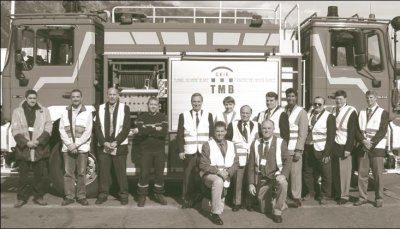U.S. Department of Transportation
Federal Highway Administration
1200 New Jersey Avenue, SE
Washington, DC 20590
202-366-4000
Increasing traffic congestion in urban areas and growing land values in the United States make underground structures increasingly attractive for highways and transit compared to other options. A tunnel can preserve the land above for parks, buildings, homes, and other uses while providing an efficient, cost-effective underground corridor to move people and goods. The United States has about 500 highway, passenger rail, and freight rail tunnels, according to the Blue Ribbon Panel on Bridge and Tunnel Security sponsored by the Federal Highway Administration (FHWA), the American Association of State Highway and Transportation Officials (AASHTO), and the Transportation Research Board (TRB). Unfortunately, only limited national guidelines, standards, or specifications are available for tunnel design, construction, safety inspection, traffic and incident management, maintenance, security, and protection against natural or manmade disasters.
The objectives of the scan were to learn what is being done internationally for underground transportation systems in the areas of safety, operations, and emergency response. The focus of the scan was on equipment, systems, and procedures incorporated into modern underground and underwater tunnels by leading international tunnel experts. The study considered the following:
Regarding the safety and security aspects, the team was interested in learning about planning approaches, standards, manpower roles and responsibilities, communication techniques, and state-of-the-art products and equipment used to deter, detect, deny, defend, respond to, and recover from both natural and manmade disasters and other incidents.
Team members were interested in not only tunnel practices and innovations for highways, but also those for passenger and freight rail.
Amplifying questions were developed to help the foreign experts more fully understand the topics of interest to the scan team members. These questions, listed in Appendix A, were provided to the host countries before the scan.
The scan team met with representatives from nine countries from September 23 to October 9, 2005. The team visited Denmark, France, Norway, Sweden, and Switzerland. While in Norway, the team also had meetings with a representative from the Netherlands. While in France the team had meetings with representatives from Germany and Italy, and while in Switzerland it met with a representative from Austria. These nine countries were selected on the basis of desk scan findings that showed they are innovators in underground transportation systems. The contacts in each country are listed in Appendix B, and the scan itinerary is in Table 1 on the following page.
The scan was sponsored by FHWA, AASHTO, and the National Cooperative Highway Research Program (NCHRP). The 11-member team consisted of three representatives from FHWA, four representatives from State departments of transportation (DOTs), one representative from the Bay Area Rapid Transit District (BART), one representative from the Massachusetts Turnpike Authority who also represented the International Bridge, Tunnel, and Turnpike Association (IBTTA), one tunnel engineering design consultant, and the report facilitator. Team member contact information and biographical sketches are in Appendix C
.Figure 1: Scan team in front of Mont Blanc Tunnel firefighting truck.

| Day, 2005 Date | Location | Activities |
|---|---|---|
| Monday, September 26 | Tronheim, Norway | Meeting with Foundation for Scientific and Industrial Research at the Norwegian Institute of Technology (SINTEF) and with representative from Center for Tunnel Safety at Dutch Ministry of Transport, Public Works, and Water Management |
| Tuesday, September 27 | Tronheim, Norway | Meeting with Norwegian Fire Research Laboratory (SINTEF NBL) and tour of E39 Motorway tunnels |
| Wednesday, September 28 | Copenhagen, Denmark | Meeting with Copenhagen Metro |
| Thursday, September 29 | Copenhagen, Denmark and Larnecken, Sweden | Meeting with Rambøll in Copenhagen, meeting with Oresundsbro Konsortiet and tour of Oresund Fixed Link tunnel, and tour of Oresund Operations Center in Larnecken |
| Friday, September 30 | Malmo, Sweden | Meeting with Citytunnel, tour of Citytunnel Exhibition Center, and meeting with Swedish National Testing and Research Institute (SP) |
| Monday, October 3 | Paris, France | Meeting with Cofiroute, tour of A86 Exhibition Center, tour of A86 East Tunnel, tour of A86/A13 tunnel interchange, and meeting with Citilog |
| Tuesday, October 4 | Lyon, France | Meeting with Tunnel Study Centre (CETU) at French Ministry of Transport, Equipment, Tourism, and Sea, and with representative from German Research Association for Underground Transportation Facilities (STUVA) |
| Wednesday, October 5 | Mont Blanc, France | Meeting with Italian representatives of Mont Blanc Tunnel Corporation and tour of Mont Blanc Tunnel |
| Thursday, October 6 | Berne, Switzerland | Meeting with Swiss Federal Roads Authority and representative from University of Graz of Austria |
| Friday, October 7 | Mitholz, Switzerland | Meeting with Berne-Loetschberg-Simplon (BLS) AlpTransit and Schneller Ritz & Partner, and tour of Loetschberg Base Tunnel |
| << Previous | Contents | Next >> |